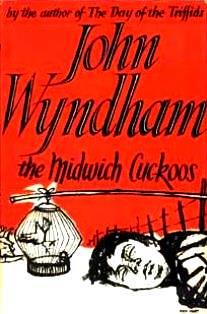
First published back in 1957, ‘The Midwich Cuckoos’ formed the seventh published novel by British author John Wyndham. The story was later adapted into the film ‘Village Of The Damned’ both in 1960 and then again in 1995.
DLS Synopsis:
Richard Gayford and his wife, Janet, had been away in London for the night of the 26th September. However, upon arriving back at Midwich, they find that the roads into the sleepy village they call home had all been closed off by the police. Something very strange had happened in Midwich during the night they had been away. Something that no one could put any reasoning to.
It appeared that anyone attempting to go anywhere near the village would instantly succumb to a deep and sudden unconsciousness. The entire village appeared to be trapped within a strange invisible blanket, with everyone caught inside it remaining unconscious.
And then, as suddenly as this strange invisible bubble had descended, its effects all of a sudden disappeared. The people of Midwich were waking from their daylong sleep. Furthermore, there seemed to be no obvious lasting effects. And as the following days pass by, people start to forget about the strange occurrence that was now simply being referred to as the ‘Dayout’.
But, after a few months pass by, a new worrying development starts to emerge. All of the women in the village capable of bearing children find that they are now pregnant. The time of the conception undoubtedly during the time of the Dayout. Furthermore, many of the women have no reason behind their sudden pregnancy. No male partners. No normal way to have become pregnant. A deep wave of concern has once again returned to engulf Midwich.
However when the Dayout babies are finally born, they appear healthy and normal. That is, other than their golden irises. And after just a short amount of time has passed, it becomes clear that something further isn’t right. The babies seem to be able to exert a form of controlling compulsion over their mothers – forcing those that had left Midwich to now return to the village.
But this is only the first signs of the controlling power that the Midwich Children have in their collective grasp. And between the thirty boys and twenty-eight girls – their influence over Midwich is slowly revealing itself to be a very definite threat…
DLS Review:
Wyndham loves to create an unnervingly out-of-the-ordinary premise for his stories without getting overly bogged down in explaining the very roots of how it all came about. Indeed, the reader needs to just accept that what is happening is happening; that from a series of events, the eventual outcome is what we see before us now. And in doing so, without the real need for backing everything up with carefully fabricated faux-logic, Wyndham is able to set in motion a story that almost quivers with intrigue within a deeply-unsettling feeling of the unknown.
‘The Midwich Cuckoos’ isn’t exactly a fast-paced novel. At first it sets off with the mysterious ‘sleep-inducing’ atmosphere that seems to have engulfed the village. And the whole unexplainable strangeness of the sudden situation instantly draws the reader into the tale. From here it’s hard not to be ensnared with the plot. Wyndham’s signature ‘never-really-explaining-the-reasoning-for-this-sudden-turn-in-events’ works to its very best effect here. That utter feeling of unknown is such a powerful draw. And you just know that more is to come. It all works in a similar way to ‘The Day Of The Triffids’ (1951), in that it’s a series of events which ultimately creates the final situation – not just one solitary incident.
Written from the perspective of our middle-aged observing protagonist, Richard Gayford, Wyndham utilises a strong amount of character-to-character narrative to tell his story. Indeed, the tale is built up and structured around a great deal of conversational directing; with the interplay between the handful of principal characters forming the vast majority of the tale’s actual delivery.
Following the ‘Dayout’ and then the eventual birth of the Dayout babies, it has to be said that the novel does take to a much more reserved pace. However, with the premise now set, Wyndham puts his mind to pondering upon a multitude of important and fundamental questions; bringing the reader into the very thick of the complex scenario with many thought-provoking questions being left exposed but still unanswered.
What ‘The Midwich Cuckoos’ ultimately delivers is a rising and almost-palpable tension that holds the whole story together. Having these unknown quantities infiltrate our race, in the same way as a cuckoo laying its eggs in another bird’s nest, so the gradual revelation of the Children’s intentions and our lack of options in preventing this dilemma, brings to the table a particularly curious and intriguing mix of thought-provoking horror with an unpretentious undercurrent of philosophical pondering.
There’s a lot in the novel to keep the reader thinking. However it does lack the immediate intensity and obvious adrenaline of Wyndham’s other novels. And the final ending is very easily predicated from a veritable mile off, leaving the reader feeling that the tale concluded with just too much of an easy ending, without anywhere near as much thought gone into it as the preceding pages had.
The novel runs for a total of 220 pages.

© DLS Reviews






